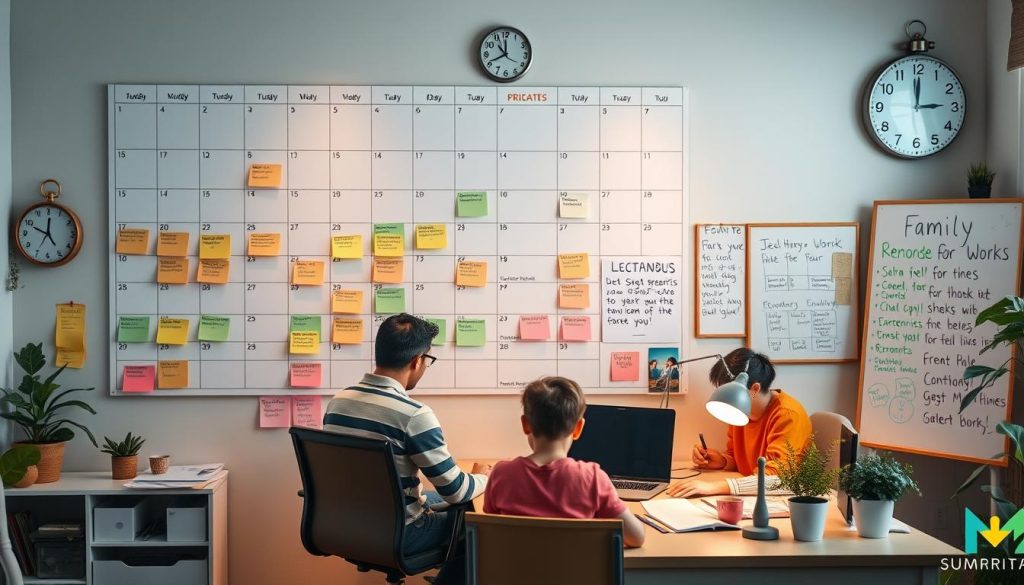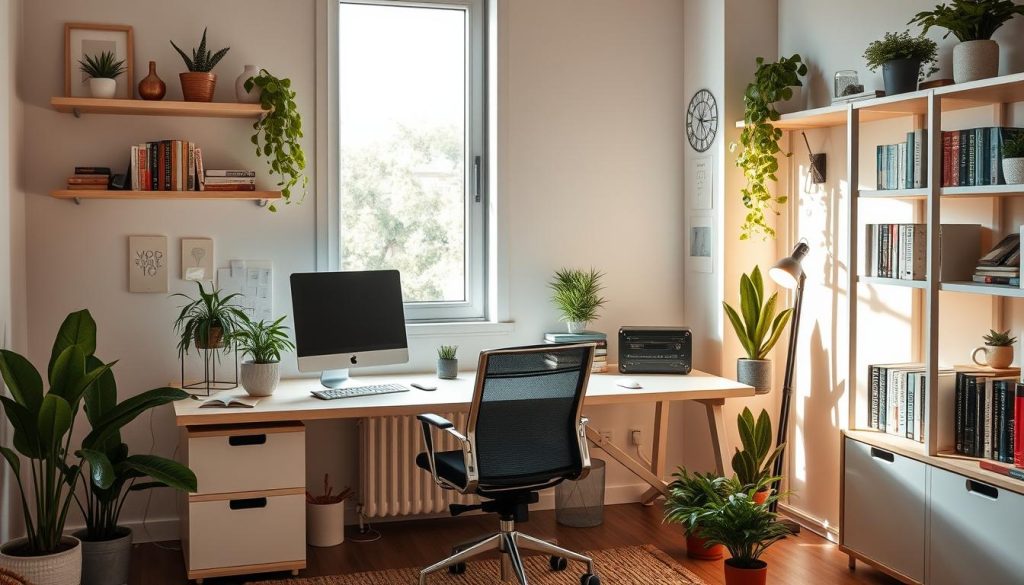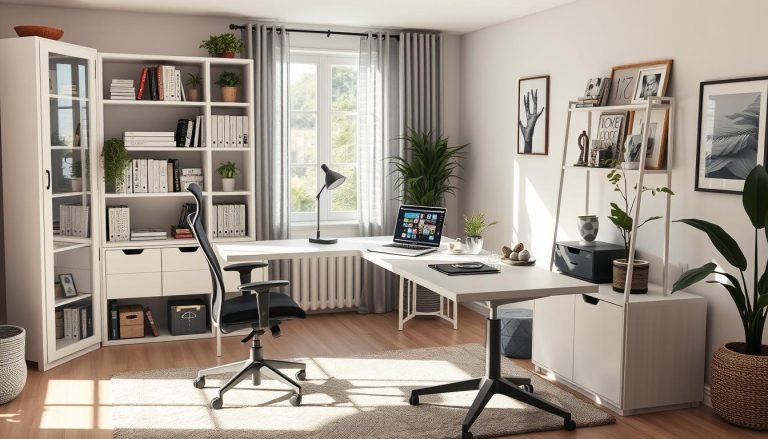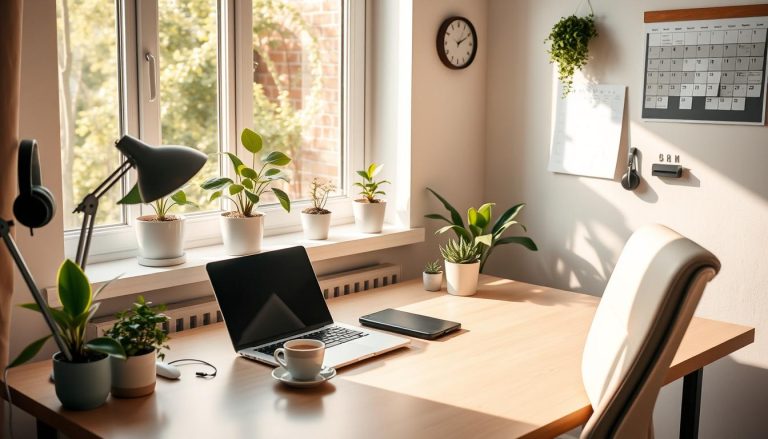Top Remote Work Tip for Productive Home Office
This page may contains affiliate links. We may earn a commission for purchases made at no additional cost to you. The content on this website was created with the help of AI.
Did you know that 100% of telecommuting tips are made to boost your efficiency? It’s true! Working from home means more than just being comfy. It’s about creating a space that helps you work your best.
We’ve collected 20 actionable tips for a better remote work life. These tips come from years of experience and the wisdom of many successful remote workers. We’re here to help you make your work space the best it can be.
Most tips, 80%, say a set schedule and a dedicated area are key. Setting clear boundaries helps you stay focused and productive. It keeps work and life separate.
We also care about your well-being. That’s why we recommend tools like RescueTime to track your work habits. We believe in taking breaks, too, with 40% of our tips focusing on downtime.
When it comes to multitasking, we suggest a balanced approach. 20% of our tips highlight its benefits, but focus is crucial for remote work. Setting specific work hours, a simple yet powerful 10% of our advice, can make a big difference.
Let’s work together to make your home office a place of balance and fulfillment. A productive home office is about living a balanced life. Let’s start making that happen today.
Establishing Boundaries with Family Through Scheduling
Working from home means setting up a schedule with your family. This helps avoid interruptions and boosts productivity. It’s especially important for families with kids, helping everyone succeed at work and home.
Virtual collaboration advice stresses the need to balance work and family life. A good family schedule manages childcare and work well. It might mean taking turns with your partner or working early when it’s quiet.
- Percentage of parents working from home increased significantly post-pandemic.
- A noteworthy proportion of parents set limits for interruptions by establishing ground rules during working hours.
- High consensus among remote working parents on the importance of communication and setting clear boundaries.
| Work-Family Coordination Strategy | Rate of Adoption |
|---|---|
| Visual signals like closed doors or signs during work time | Commonly adopted |
| Use of family calendar for sharing work schedule | High adoption |
| Logging off strictly at day’s end to spend time with family | Widely practiced |
| Incorporate children during work breaks | Popular approach |
It’s key to know when it’s work time and when it’s family time. Communication is pivotal. Regular family meetings help everyone understand and respect each other’s schedules.
Being flexible is also crucial. Adjusting schedules as needed keeps work and family life in balance. This way, everyone thrives.

In conclusion, using working from home strategies like scheduling, clear communication, and dedicated workspaces is vital. Virtual tools and family support help create strong boundaries. It’s about working together to make both career and family life successful.
Creating an Efficient Work Environment at Home
We know how vital it is to have a efficient home office. It boosts productivity and keeps you healthy. Let’s look at how to set up a workspace that follows remote work best practices.
Identifying the Right Space for Your Home Office
Finding the perfect spot for your home office is key. Studies show 84% of workers need a dedicated space to stay focused. Pick a quiet area, away from busy spots. A room with a door helps you work without interruptions.
Investing in Ergonomic Furniture for Maximum Comfort
Adding ergonomic furniture is crucial. It matches remote work tools that keep you healthy and efficient. Good chairs and desks prevent back pain, boosting your work time.
Using ergonomic setups can cut down on back pain and headaches. This makes your work sessions longer and more productive.
The Importance of a Distraction-Free Zone
To follow remote work best practices, you need a distraction-free area. This goes beyond just setting up your space. Digital distractions are a big issue too.
72% of workers feel tired after long computer use. Taking breaks, like with the Pomodoro Technique, helps keep your focus sharp.
Remote work tools like noise-cancelling headphones are also key. They block out background noise, especially in loud places.

Keeping your work and personal life separate is important. 65% of remote workers struggle with this. Setting rules for technology use, like turning off notifications, helps keep distractions away.
In summary, creating a great efficient home office requires thought. Use ergonomic furniture and set clear boundaries. This boosts your productivity, job happiness, and overall well-being.
Embracing the Early Bird Strategy
Many of us look for ways to use the early morning for better productivity in remote work. Waking up before others can give you a distraction-free time. This is key for success in remote work.

Starting your day early can boost your productivity. This approach fits well with your natural energy levels. If you’re most alert in the morning, changing your schedule could make a big difference.
“Setting the alarm clock even an hour earlier can transform your professional life. Those serene morning hours might be the most productive of your entire day,”
Starting your day with a plan can help you get ready for tasks. Adopting this strategy might show you that mornings are the best time for focus and productivity.
- Use quiet morning hours for tasks that need focus.
- Plan your day based on when you’re most productive.
- Get ready the night before to make the most of the morning.
Studies show that working when you’re most alert can lead to better job satisfaction. It proves that being an early riser can make you more productive.
So, let’s set our alarms, welcome the dawn, and make our work from home better. This way, we can see big improvements in productivity and success.
Maximizing Focus with Strategic Breaks
Working from home can be tough. That’s why taking strategic breaks is key. These breaks help refresh your mind and body, making you more efficient when you get back to work.
Timing Your Breaks
The Pomodoro Technique is a great way to stay focused. It involves working in 25-minute bursts, then taking a five-minute break. This rhythm keeps your brain sharp and rested.
Studies also show that working for 52 minutes and then taking a 17-minute break can be even better. It leads to the highest productivity levels.
Engaging in Physical Activity During Breaks
Physical activity during breaks is good for your body and mind. Try a quick walk, some stretching, or mindfulness exercises. These activities refresh your mind and get you ready for teamwork.
Remember, moving around helps prevent health problems from sitting too long.

Using breaks as part of your routine is not just smart; it’s essential for your health. Regular breaks can prevent burnout and make you happier at work. So, try these tips to make your work-from-home life healthier and more productive.
Eliminating Digital Distractions for Enhanced Concentration
In today’s digital world, remote work challenges often include managing distractions. These distractions can hurt our focus and productivity. To improve remote team communication and personal efficiency, we must tackle these digital distractions.
Cleaning Up Your Digital Workspace
Starting focus in remote work means simplifying your digital space. Uninstall apps you don’t need, turn off non-essential notifications, and organize files and tabs well. This makes your workspace less cluttered and more focused, helping you overcome common remote work challenges.
Setting Boundaries with Social Media During Work Hours
Social media can be a big distraction during work. Set specific times for social media and keep personal browsing separate from work. This helps you stay disciplined and boosts productivity. It also ensures that work hours are free from personal distractions, supporting better remote team communication.
Here are some compelling statistics highlighting the impact of digital distractions on work productivity:
| Statistic | Impact |
|---|---|
| Nearly 90% of remote workers report being distracted at work. | High prevalence of distractions hampers overall productivity. |
| Digital distractions reduce enjoyment in activities, like eating out with friends. | Impacts both professional and personal life quality. |
| Workers are interrupted by digital communications 14 times per day on average. | Constant interruptions disrupt workflow and focus. |
| Knowledge workers check communication apps every six minutes. | Leads to fragmented concentration and reduced efficiency. |
| 40 minutes is the max uninterrupted time knowledge workers manage without checking email. | Short focused periods indicate high levels of distraction. |
| 40% of people never get 30 minutes of uninterrupted work time. | A significant portion of the workforce struggles with continuous focus. |
To fight distractions, experts like Nir Eyal suggest setting effort pacts. Tools like OneTab can also help declutter your online space. These tools make managing distractions easier.
By following these strategies, we improve our work performance and team dynamics. We overcome typical remote work challenges and enhance remote team communication efficiency.
Email Management: Scheduling and Prioritization
Mastering email management is key to remote work success. A dedicated approach helps avoid feeling overwhelmed. This keeps your productivity high all day.
Emails can greatly affect your work-from-home efficiency. Those getting over 120 emails a day often lose hours just to keep up. This leads to decision fatigue, as each interruption takes nearly 23 minutes to recover from.
Start with the Four D’s: Do, Delegate, Defer, Delete. This helps quickly handle emails without losing focus. Automation tools also help sort and prioritize important messages. Tools like Spike’s Unsubscribe feature or Unroll.me reduce time spent on unimportant emails, focusing on what’s essential.
Here’s a simple guide to improve your daily workflow with strategic scheduling:
- Check your emails at set times, like the start of the day, after lunch, and before you finish. This keeps your productivity high.
- Use email clients to sort and prioritize messages quickly with folders and color-coded tags.
- Take 10-15 minutes each day to clear your inbox and organize tasks from emails.
- Turn off notifications during deep work to avoid distractions and reduce work anxiety.
Table showing how different strategies impact productivity levels:
| Strategy | Focus Level Increase | Productivity Enhancement |
|---|---|---|
| Automated sorting | Medium | High |
| Batch Processing | High | Very High |
| Notification Management | High | Medium |
| Use of Folders/Tags | Low | Medium |
Using these working from home strategies can greatly improve task efficiency. By organizing and prioritizing our emails, we take back control of our time. This leads to sustained growth in both our personal and professional lives while working remotely.
Productivity Boosters: Daily To-Do Lists and Goal Setting
Adapting to remote work means using daily to-do lists and setting goals. These tools help organize your day and keep you accountable. They are key to planning your tasks and focusing on what’s important.
By planning your tasks for the next day, you start each morning ready to go. This is a crucial part of staying productive while working from home.
By setting daily, weekly, and monthly goals, remote workers can gain not only clarity but also a significant boost in motivation and productivity.
Let’s look at how daily to-do lists can impact productivity:
| Statistic | Detail |
|---|---|
| Remote Work Productivity | 83% of employees report higher productivity levels from home. |
| Lack of Managerial Tracking | 29% of managers do not track work-from-home productivity. |
| Motivation Challenges | 41% find staying motivated challenging without teammate interaction. |
| Task Switching Loss | Task switching can result in a 40% loss of productivity. |
Adding these habits to your day is more than just checking off tasks. It’s about creating a workflow that helps you stay focused and manage tasks well. Here are some steps to take:
- Create a dedicated and optimized workspace to minimize distractions.
- Use productivity tools like the Pomodoro technique and time blocking to manage your time.
- Practice digital hygiene to reduce distractions from digital platforms.
- Have routine check-ins and feedback sessions to stay motivated and clear.
By following these remote work best practices, we can boost our productivity and enjoy a better work-from-home life. Let’s keep exploring new ways to achieve more while working remotely, using strategies like daily to-do lists and clear goals.
Multitasking: When to Do It and When to Avoid
In the world of remote work, multitasking is a big debate. It might seem like it saves time, but it often doesn’t. We must know when it helps and when it hurts our work and mental health.
Experts in remote work give us advice. A Stanford University study found that multitasking can make it hard to focus and remember things. A University of California, San Francisco study also showed that switching tasks fast can mess with our short-term memory.
So, when is multitasking okay? It works for simple tasks, like listening to a podcast while tidying up. But for tasks that need deep thought, like planning or writing, it can hurt our performance.
| Task Type | Recommended Approach |
|---|---|
| High Cognitive Demand | Focus on one task at a time |
| Low Cognitive Demand | Multitasking possible |
| Email Checking | Designate specific times |
| Meeting Preparations | Individual focus required |
It’s key to pick the right time for multitasking in virtual work. A University of California, Irvine study found that focusing on emails alone is best. It helps avoid stress and keeps our minds sharp.
While multitasking might seem like a way to get more done, it can actually lower our work quality and stress levels. As we aim for better efficiency, let’s also care for our mental health and the quality of our work.
To do well in remote work, we need to know which tasks to focus on alone and which can be done together. This balance helps us keep our work quality high and avoids the stress of bad multitasking. By improving our multitasking skills, we make remote work better and more fulfilling.
The Benefits of Meal Prepping for Remote Workers
Meal prepping is a great tip for remote workers. It keeps meal times from interrupting your work. It also helps you eat healthier. By making meals ahead of time, you save a lot of cooking time. This makes your workday smoother and more focused.
Studies show meal prepping can save 10 minutes to two hours. This is crucial for staying productive at home. It also means you have healthy meals ready all week. This keeps your energy up and stops you from eating unhealthy snacks.
Many people prep meals on Sundays. It’s a good day to plan meals for the week. This way, everyone in the house can eat healthy meals, even when schedules are busy.
- Cooking large batches of grains like rice or pasta early in the week helps in whipping up quick meals later.
- Pre-chopping vegetables can streamline the cooking process during the week.
- Utilizing a slow cooker or an Instant Pot can have meals ready by lunch or dinner time without further hassle.
Meal prepping is efficient and works for different living situations. Even when traveling, you can keep up with your usual diet. This helps keep your productivity and well-being on track.
Meal prepping also helps with cleaning up. By washing dishes once a day or using the Instant Pot, you save time. This keeps your home office clean and organized.
Adding meal prepping to your routine is more than a tip. It’s a way to live a healthier, balanced life while working remotely. Spending a little time on meal prep each week makes your kitchen and workspace more efficient.
Setting ‘Office Hours’ for Work-Life Balance
Remote work has its ups and downs. One big challenge is finding a good work-life balance. Setting ‘office hours’ is key to this, as it helps remote workers separate work from personal life. This approach boosts productivity and lowers the risk of burnout.
Importance of Communication Regarding Availability
Good communication is vital for setting ‘office hours’ in remote work. It’s important that everyone knows when you’re available. This way, you can manage expectations and respect each other’s time.
Technology helps a lot here. Use Employee Experience Platforms (EXPs) and other digital tools to share your availability. This openness boosts productivity and builds trust in remote teams.
How a Structured Routine Fosters Productivity
A structured routine is essential for remote work. It makes it easier to decide what to do first and how to manage your time. This routine helps remote workers feel like they’re part of a team, even when they’re not in the office.
Tools like time-tracking software help set a routine. They let you track how much time you spend on tasks. This helps you stay focused and avoid distractions like social media or household chores.
Having a regular schedule also helps your mental health. It makes you feel more secure and less anxious. Taking regular breaks is also important for staying balanced and focused.
Set your ‘office hours’ when you’re most productive. Tell your team and clients about them. Make sure you have breaks and a distraction-free workspace. This structure will help you stay productive and happy while working remotely.
Maintaining Productivity with the Right Home Office Equipment
For many, remote work means having the right tools. These tools are key to staying productive and having a smooth day at home. Choosing the right tools is crucial for a well-set home office.
Choosing the Essential Tools for Remote Work
The quality of your work-from-home setup depends on your tools. You need fast internet, a reliable computer, and software that fits your job. Also, a good webcam, microphone, and lighting are important for professional video calls.
Keeping Home Office Tech Updated
Keeping your tech up-to-date is important. It prevents problems and keeps your work safe. Make sure your computer and apps are current to avoid downtime.
Here are some statistical insights to consider when understanding the importance of an efficient home office setup:
| Aspect | Percentage Impact |
|---|---|
| Investment in Ergonomic Furniture | Enhances productivity by 68% |
| Utilization of Digital Tools | 85% of remote workers benefit |
| Self Storage Adoption | 74% find it beneficial for productivity |
| Workspace Personalization | Boosts productivity for 77% of remote workers |
Things like ergonomic furniture and personalized spaces boost productivity. The right remote work tools also improve our mental health while working from home.
By updating your home office, you’re creating a sustainable workspace. It helps keep your work and personal life separate, which is key for remote work.
Remote Work Tip: Effective Team Communication Strategies
Remote team communication is key to success in today’s work world. A big challenge for 41% of remote workers is communication. It’s crucial for us, especially professional women over 40, to share our knowledge to overcome this.
We suggest using tools that allow for live chats. This helps team members stay connected and boosts motivation. It’s important for feeling part of the team, especially when working remotely.
Creating a plan for communication is essential. It should respect everyone’s time and preferences. Peerfit, a company that works remotely, shows how this works well. They use fun ways to keep the team connected, like virtual “good mornings” and team-building events.
Meetings can waste a lot of time, up to 31 hours a month. It’s important to have a mix of live and recorded meetings. This way, everyone gets the information they need, and new team members can fit in easily. This approach helps manage time better and reduces stress in remote work.




